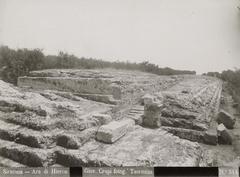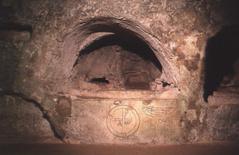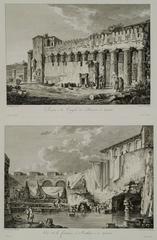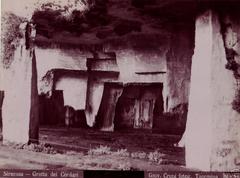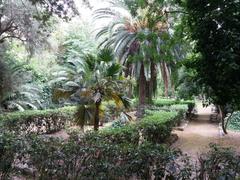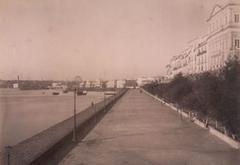Ipogeo di Piazza Duomo Syracuse: Visiting Hours, Tickets, and Travel Guide
Date: 04/07/2025
Introduction
Beneath the storied Piazza Duomo of Ortigia—the historic core of Syracuse, Sicily—lies the remarkable Ipogeo di Piazza Duomo. This subterranean complex weaves together centuries of Greek ingenuity, Roman urban planning, medieval adaptation, and modern resilience. As both an archaeological and cultural landmark, the Ipogeo offers visitors a unique journey through the layers of Syracuse’s past. From its earliest function as a quarry and aqueduct to its role as an air raid shelter during World War II, the Ipogeo encapsulates the ever-evolving story of the city. This guide provides detailed information on the history, architecture, visitor experience, opening hours, ticketing, accessibility, and insider tips, drawing upon authoritative sources such as Zainoo, My Guide Sicily, and the Comune di Siracusa.
Discover the Ipogeo: Syracuse’s Subterranean Treasure
Concealed below the vibrant Piazza Duomo, the Ipogeo di Piazza Duomo is a labyrinthine hypogeum that invites exploration. Stretching beneath the cathedral and extending toward the seafront, it is a living testament to the city’s adaptability and the resilience of its people. Whether you are an archaeology enthusiast, a lover of history, or a curious traveler, the Ipogeo promises an immersive experience connecting you to the heart of Mediterranean civilization.
Historical Context and Evolution
Greek Origins and Roman Expansion
The origins of the Ipogeo di Piazza Duomo trace back to the founding of Syracuse by Greek settlers in the 8th century BCE. The soft limestone beneath Ortigia was quarried to construct monumental buildings, and over time, these subterranean spaces were expanded and repurposed by the Romans after 212 BCE (Zainoo, PlanetWare). Initially, these tunnels served practical functions such as water management and storage, and as secret passageways connecting key civic and religious sites.
Medieval and Early Modern Adaptations
During the medieval and early modern eras, the Ipogeo continued to serve Syracuse’s evolving needs. Residents used the cool underground chambers for storage and as passageways during times of unrest. Its proximity to the city’s religious and civic center ensured its maintenance and adaptation through Norman, Swabian, and Spanish Bourbon rule (Italy Heaven).
World War II: Shelter Amidst Destruction
The hypogeum’s most poignant chapter came during World War II. In July 1943, as Allied forces bombarded Syracuse during Operation Husky, the tunnels were converted into air raid shelters by the Unione Militare Protezione Antiaerea (U.M.P.A.), providing protection for civilians (HitSicily, Comune di Siracusa). Today, these events are commemorated through exhibitions and memorials within the Ipogeo.
Rediscovery and Restoration
Rediscovered in the late 19th century and restored in the 21st, the Ipogeo is now open to the public. It serves as both a historical monument and a place of reflection on Syracuse’s enduring spirit (ShowCaves).
Architectural Features and Layout
The Ipogeo is a network of galleries, tunnels, and chambers carved into limestone, descending up to 20 meters below Piazza Duomo (ShowCaves). Key features include:
- Main Tunnel: Running east-west, partially barrel-vaulted, linking Piazza Duomo to the Marina walls.
- Side Branches: Connecting the Archbishop’s Palace and the Giardini dell’Arcidiocesi.
- Cistern: The vast Archbishop’s cistern, built in the 17th century, played a crucial role in Ortigia’s water supply.
- Quarry Sections: Evidence of ancient stone extraction for the cathedral’s façade.
The stonework bears marks from different eras, with a blend of ancient quarrying, medieval modifications, and 20th-century reinforcements. The absence of natural light, echoing chambers, and shadowy corridors create a mysterious, atmospheric environment (My Guide Sicily).
Cultural Significance and Symbolism
The Ipogeo di Piazza Duomo is a cultural artifact embodying Syracuse’s resilience and adaptability. Its function as an air raid shelter is especially significant, symbolizing civilian endurance during wartime (My Guide Sicily). Furthermore, its role in the protection of religious relics—such as the silver simulacrum of Saint Lucia—underscores its spiritual significance (citymapsicilia.it). The hypogeum’s mysterious corridors have fueled local legends and folklore, deepening its allure for visitors.
Visiting Information: Hours, Tickets, and Access
Location and Access
- Address: Piazza Duomo, Ortigia, Syracuse, Sicily, Italy (Tripexpert)
- Entrance: Along the garden wall of Piazza Duomo, near the Archbishop’s Palace.
- Getting There: Ortigia is pedestrian-friendly; public transport and paid parking are available nearby. Vehicle access is restricted in the historic center (italialikealocal.com).
Opening Hours (2025)
- Seasonal Opening: March 21 to July 21 (for the 20th anniversary of Syracuse’s UNESCO listing) (Hermes Sicily).
- Standard Hours: 8:30 AM to 1:00 PM (extended to 7:00 PM during special events).
- Last Entry: 15 minutes before closing.
- Note: Always check official updates prior to your visit as hours may change seasonally.
Tickets
- Admission: Entry is often free, especially on the first Sunday of the month and during special events.
- Reservations: Access is typically by reservation only; group visits and guided tours can be booked through local operators (Hermes Sicily).
- Ticket Office: On-site, closes 15 minutes before the site.
- Online Booking: Recommended for peak periods; check the official museum website.
Accessibility
The hypogeum features uneven floors, narrow passages, and stairs, making it unsuitable for visitors with significant mobility challenges or claustrophobia (My Guide Sicily). Contact the visitor center in advance for specific questions on accessibility.
Guided Tours and Visitor Experience
- Guided Tours: Highly recommended for historical context and access to restricted sections. Local guides share insights into the Ipogeo’s history and architecture (Hermes Sicily).
- Virtual Tours: Available online for remote exploration (museumrun.com).
- Interpretation: Informational panels, period photographs, and thematic maps enrich the visitor experience.
- Atmosphere: Expect cool, dimly lit tunnels with echoes and the sound of dripping water. Bring a light jacket and wear sturdy shoes.
What to Expect During Your Visit
- Duration: Visits last 30–60 minutes, depending on tour depth.
- Exhibitions: Includes displays on World War II, the 1943 bombing, and the evolution of the tunnels (Enjoy Sicilia).
- Photography: Allowed in most areas; flash may be restricted.
- Best Times to Visit: Morning or late afternoon for fewer crowds and cooler conditions.
Tips for a Memorable Visit
- Book in Advance: Essential due to limited opening periods and visitor capacity.
- Dress Smart: Wear comfortable shoes and a sweater for the cool underground environment.
- Combine Visits: Pair with the Syracuse Cathedral, Castello Maniace, or a walking tour of Ortigia for a comprehensive experience.
- Accessibility: Confirm options ahead if you have mobility concerns.
- Respect Restrictions: Follow signage regarding photography and restricted areas.
Nearby Attractions
- Tempio di Apollo: One of Sicily’s oldest Doric temples.
- Fountain of Arethusa: A legendary freshwater spring.
- Charming Ortigia Streets: Ideal for exploring local shops and cafes.
FAQs
Q: What are the Ipogeo di Piazza Duomo visiting hours?
A: Seasonally open from March to July, typically 8:30 AM–1:00 PM with extended hours for special events. Always check official updates.
Q: How much do tickets cost, and how do I book?
A: Admission is often free; guided tours may incur fees. Reservations are essential and can be made via local operators or online.
Q: Is the Ipogeo accessible for people with disabilities?
A: Accessibility is limited due to stairs and narrow tunnels; contact the site in advance for specific needs.
Q: Are guided tours available?
A: Yes, and they are highly recommended for a deeper understanding.
Q: Can I take photos inside?
A: Generally permitted, but flash and tripods may be restricted in certain areas.
Visual and Interactive Resources
- Virtual tour of the Ipogeo di Piazza Duomo
- Map showing location in Ortigia, Syracuse
- High-quality images with alt text, e.g., “Ipogeo di Piazza Duomo underground tunnels in Syracuse.”
Summary and Visitor Tips
The Ipogeo di Piazza Duomo is a living chronicle of Syracuse’s layered history. Its tunnels have served as Greek quarries, Roman aqueducts, and World War II shelters, bearing witness to centuries of adaptation beneath a vibrant city. With accessible visiting hours, affordable ticketing, and expert guided tours, the Ipogeo is an essential stop for history lovers and travelers seeking to explore beneath the surface of Sicily’s heritage. Combine your visit with other nearby landmarks, and utilize digital resources like the Audiala app for a richer experience. Book ahead and consult official sources for the latest updates (Hermes Sicily, Enjoy Sicilia, PlanetWare).
Sources and Further Reading
- Ipogeo of Piazza Duomo: Visiting Hours, Tickets, and Exploring Syracuse’s Historic Underground Site, Zainoo
- Exploring the Ipogeo di Piazza Duomo in Syracuse: My Guide Sicily
- Ipogeo di Piazza Duomo Visiting Hours, Tickets & Guide, Comune di Siracusa & Hermes Sicily, Hermes Sicily
- Ipogeo di Piazza Duomo in Syracuse: TravelsHelper & CityMapSicilia, CityMapSicilia
- Ipogeo di Piazza Duomo Visiting Information, ShowCaves & Enjoy Sicilia, Enjoy Sicilia
- PlanetWare - Syracuse Tourist Attractions
- Italy Heaven - Syracuse, Sicily
- HitSicily - Hypogeum of Piazza Duomo Historical Testimony
- Bewitched by Italy - Visit to Syracuse Sicily
- Understanding Italy - Italian Top Historical Events
- Italy Beyond the Obvious - Syracuse Guide
